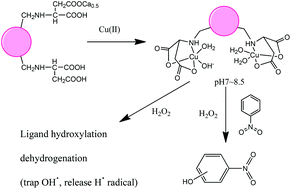Two new m-xylene/cyclohexane-linked bis-aspartic acid ligands, Lb and Lc, were synthesized via Michael addition in basic aqueous solution. Their structures were characterized by elemental analysis, NMR and MS spectrometry. Both ligands react with Cu(II) and Zn(II) to form dinuclear complexes, with M2L(OH)− the major species in neutral/weak basic aqueous solution. To quantify the relative interaction strength between a Lewis acid and base, a new parameter σ = log K/14 was proposed which compares the stability constant with the binding constant between H+ and OH−. The dinuclear copper complexes (Lb–2Cu and Lc–2Cu) react with H2O2 in aqueous solution. The reaction in 0.020 M phosphate buffer at pH 7.5 is first-order for [Lc–2Cu], but second-order for [Lb–2Cu]. The oxidation products are oxygenated and/or dehydrogenated species. Radical trapping tests indicate that both complexes slightly scavenge the OH˙ radical, but generate the H˙ radical. Lc–2Cu generates the H˙ radical much more effectively than that of Lb–2Cu when reacted with H2O2. Both complexes are excellent catalysts for the oxidation of nitrobenzene in the presence of H2O2 in weakly basic aqueous solution. The oxidation follows the rate-law v = k[complex][nitrobenzene][H2O2]. The k values in pH 8.0 phosphate buffer at 25 °C are 211.2 ± 0.3 and 607.9 ± 1.7 mol−2 L2 s−1 for Lb–2Cu and Lc–2Cu, respectively. The Arrhenius activation energies are 69.4 ± 2.2 and 70.0 ± 4.3 kJ mol−1 for Lb–2Cu and Lc–2Cu, respectively, while the Arrhenius pre-exponential factors are 2.62 × 1014 and 1.06 × 1015, respectively. The larger pre-exponential factor makes Lc–2Cu more catalytically active than Lb–2Cu. These complexes are some of the most effective oxidation catalysts known for the oxidation of nitrobenzene.

You have access to this article
 Please wait while we load your content...
Something went wrong. Try again?
Please wait while we load your content...
Something went wrong. Try again?


 Please wait while we load your content...
Please wait while we load your content...